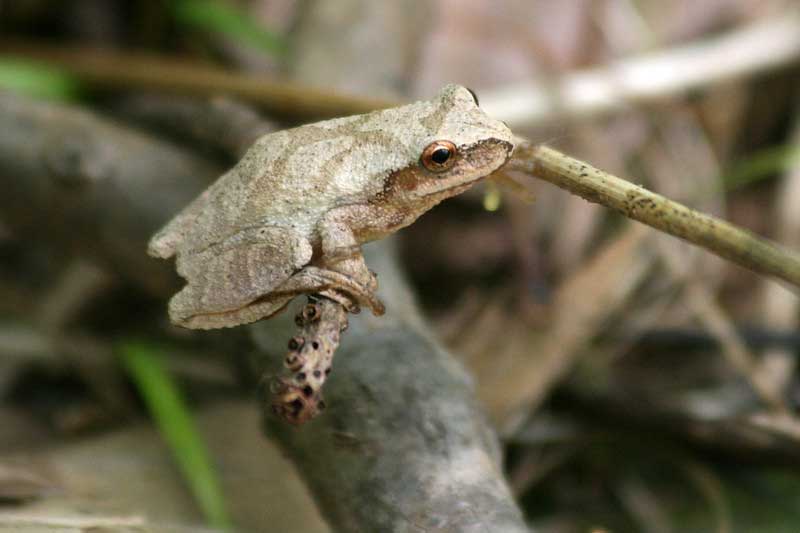There are over species 800 worldwide. While some U.S. states have as many as 16 different species, but there are 7 types of tree frogs in New York which is the state we’re covering in this article. These frogs are all in the Family Hylidae. Keep reading to learn a little about these 7 species and look at some pictures of them.
Technically, living in trees isn’t what defines a tree frog. Real tree frogs have a specialized bone in their toes that is shaped like a claw and specialized toe pads that allow them to climb trees. Species that live at ground level have lost these toe pads.
Let’s have a look at New York’s tree frogs!
7 types of tree frogs in New York
The 7 tree frogs of New York are the gray tree frog, Cope’s gray tree frog, northern cricket frog, spring peeper, western chorus frog, upland chorus frog, and the boreal chorus frog.
1. Eastern Gray Treefrog
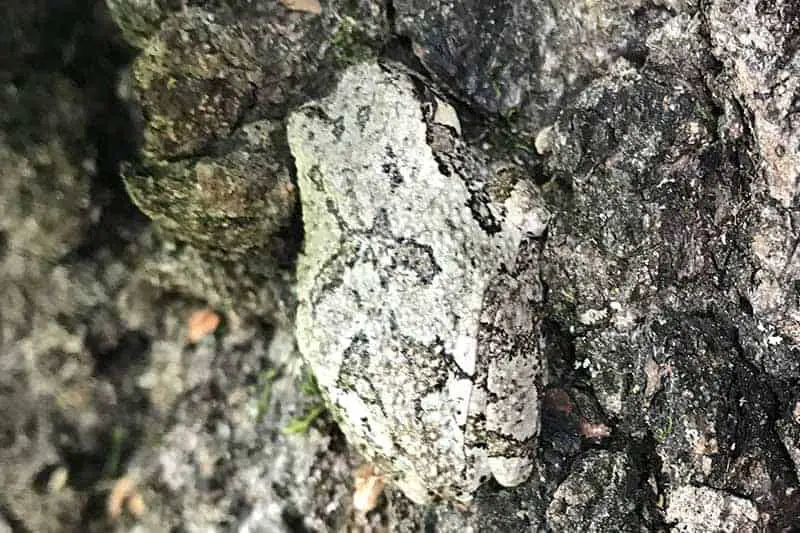
Scientific Name: Hyta versicolor
The Eastern Gray Treefrog is larger, measuring 1 1/4 to two inches. As the name suggests, it is often gray in color. It can also be green or brown. it has a dark blotch on its back, which makes it easily recognizable. Its underside is are bright yellow or orange. The skin will be rough and warty.
Gray tree frogs are found throughout all of New York. When it comes to the Allegheny Mountains, sightings are questionable. It extends through most of the Eastern U.S., excluding Maine and southern Florida.
Gray tree frogs prefer small trees or shrubs near or growing from permeant bodies of water. It stays in the trees the majority of the time. At night, it climbs down to breed and call.
Calling begins with the frogs high in the trees. Eventually, it moves down to ground level near the breeding site. They call most often in spring and early summer at twilight.
2. Cope’s Gray Tree Frog
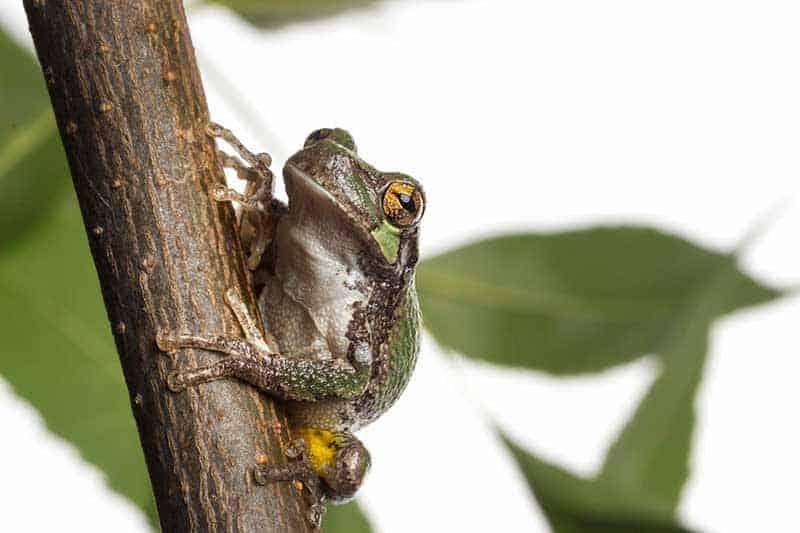
Scientific name: Dryophytes chrysoscelis
Frequently referred to as the Southern gray tree frog, the Cope’s gray tree frog overlaps that of the common eastern gray tree frog. Because of that I can assume they are also common throughout New York. What differentiates the Cope’s gray tree frog from the gray tree frog is its higher-pitched and faster-paced call and this is the only difference between the two species.
In terms of habitat, the Cope’s gray tree frog lives in woodland areas and they move to ponds for breeding.
These frogs are primarily solitary frogs, but they do form choruses that allow them to call when they’re together. You can sometimes even hear these frogs responding to loud noises during the day.
3. Northern Cricket Frog
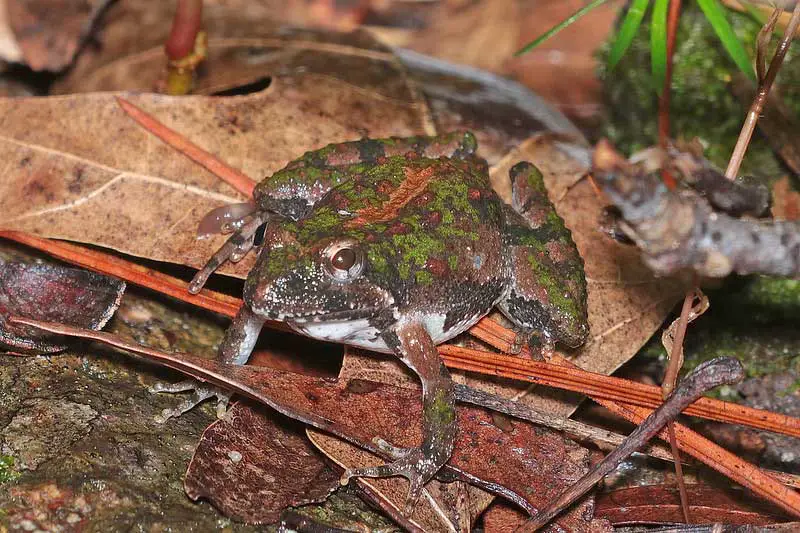
Scientific Name: Acris crepitans
The Northern Cricket Frog, often referred to as the eastern cricket frog, is a small species. It’s only five-eighths to 1 3/8 inches long. Its range extends from extreme southern New York to the Florida panhandle, and west to the outskirts of Texas.
Unlike most tree frogs, the cricket frog has warty, rough skin similar to a toad. Its body is gray with a black stripe on each side. It also has a dark triangular shape on its head.
Cricket frogs can be difficult to spot because its coloring allows it to camouflage itself in the grass near the shoreline.
It prefers shallow ponds and small streams when it takes to the water. It spends most of its time on the shoreline, preferring vegetated areas that offer lots of cover.
The cricket frog’s long legs allow it to make big leaps. It uses this ability to catch insects, often in mid-air.
The male frog calls using a throat pouch. The sound is similar to a cricket, which is likely where the frog gets its name. The call starts slowly and speeds up, lasting for 20-30 individual beats.
4. Spring Peeper
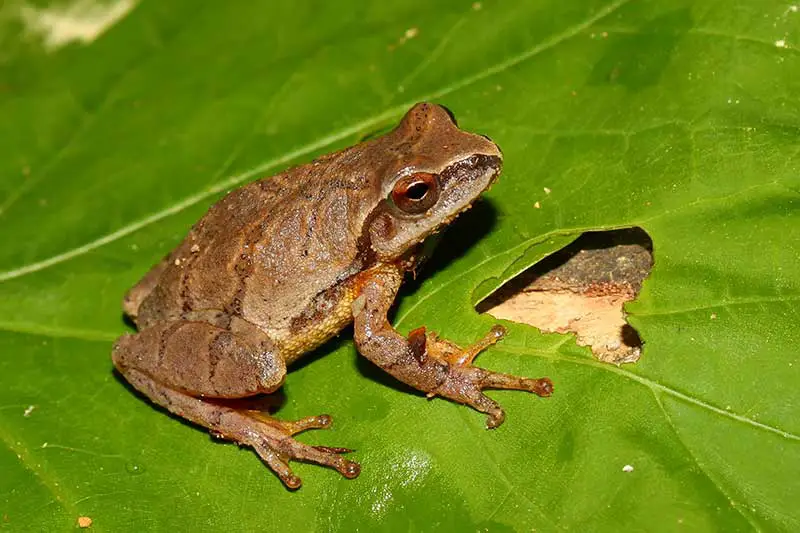
Scientific Name: Pseudacris crucifer
The Spring Peeper is thought to be the most common tree frog in New York, even though it is rarely spotted. It’s slightly smaller than the cricket frog, with adults reaching three-fourths to 1 1/4 inches long.
Spring peepers are found throughout New York and their range extends from Canada through the eastern third of the United States.
It’s found near permeant bodies of water. It can live near temporary bodies of water, but it will not be found near polluted waters. It prefers dense wooded areas, where it makes its home in the trees.
The top of its body can be tan, light brown, or gray. The underside will be lighter than the body. It has a dark V shape on its back, and bands of color on its legs.
Spring peepers hibernate during the winter months, often beneath logs or loose bark. It reappears in March, and signals the beginning of spring.
When the peeper begins to call, it does so both day and night. The call signals the beginning of spring, and often comes with spring rains. As the season goes on, the peepers only call at night.
Instead of calling individually, peepers create a chorus. The call is described as a high whistle.
The peeper isn’t a picky eater. It eats small invertebrates, including flies, grubs, and ants.
5. Upland Chorus Frog

Scientific Name: Pseudacris feriarum
Upland chorus frogs are relatively small, at 3/4 – 1 1/2 inches. They’re found in much of New York, but are more common in southern states.
Coloring and markings vary. They are typically gray, green, or light brown. They have a dark stripe down both sides of the body. The legs have dark spots or bars.
They prefer woodlands, marshes, and meadows. They breed near water, and can often be found in the water during the breeding season.
6. Western chorus frog
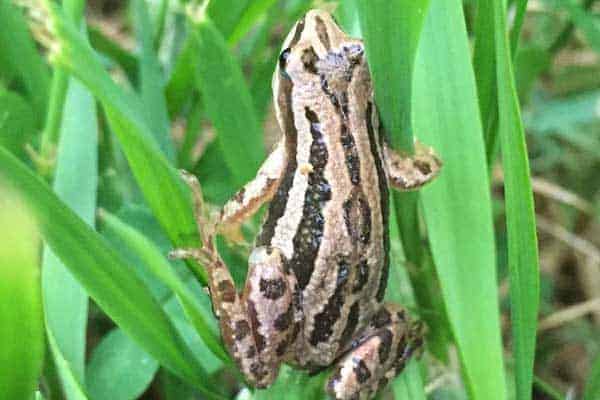
Scientific name: Pseudacris triseriata
The western chorus frog is only found in far western parts of New York state. They’re found throughout much of the midwest and eastern United States. South of Arkansas, Illinois, and Indiana, you’ll find the upland chorus frog.
Western chorus frogs are one of the smallest tree frogs in New York, and the country. As adults they are sometimes less than an inch in length. They prefer living near wooded areas, ponds, marshes, wetlands, or slow moving bodies of water.
The color varies and may be anywhere from greenish gray to brown. You can identify them by the 3 dark stripes going down their backs and their small size. They are very difficult to distinguish from boreal frog that’s up next. Though it’s believed that the western variety has longer legs.
7. Boreal chorus frog

Scientific name: Pseudacris triseriata maculata
The boreal chorus frog is a subspecies of the western chorus frog. They are rare in New York and until recently researchers thought only the western variety occurred in New York, but specimens of the boreal variety have been discovered in low lying areas of the Great Lakes plain in recent years.
These frogs are brown, reddish, tan, gray or olive in color with 3 dark stripes along their backs. They’re about 1.5 inches in length as adults and their range does overlap with the western chorus frog in some places. The boreal variant is much more common in Canada than it’s cousin.
You may also like:
